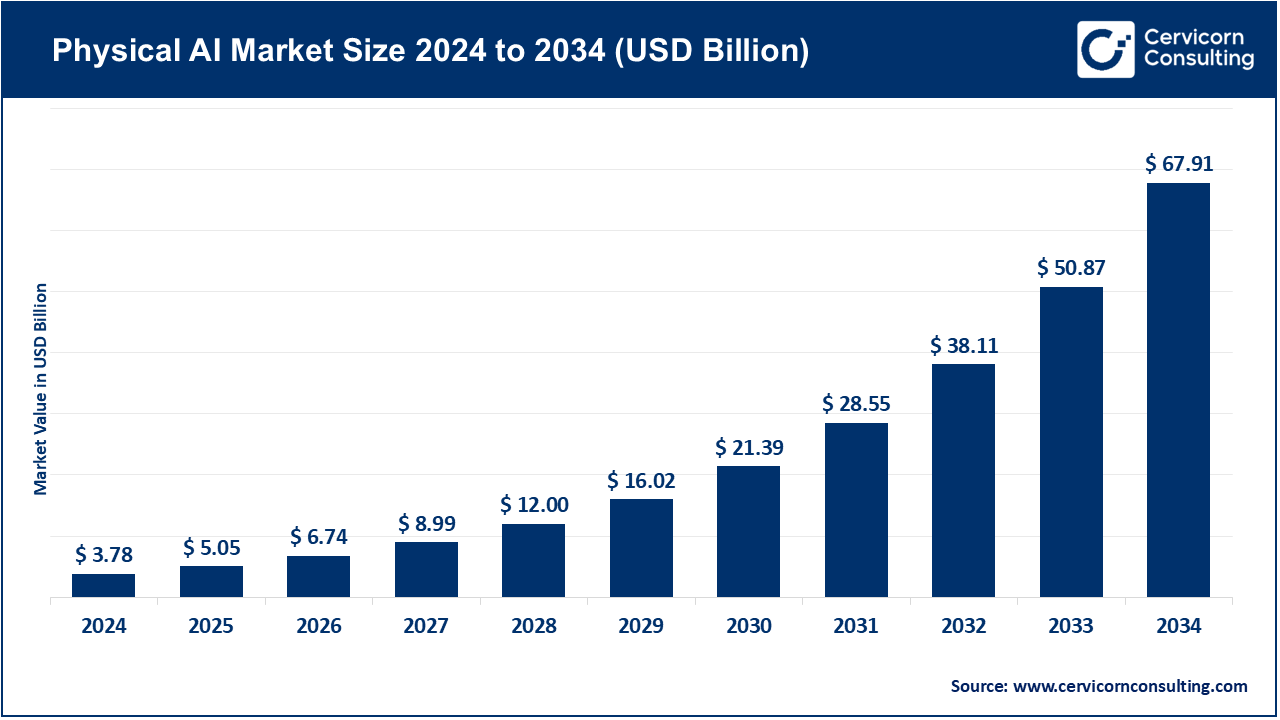Physical AI Market Overview
The global physical AI market was valued at USD 3.78 billion in 2024 and is projected to climb to nearly USD 67.91 billion by 2034, growing at an impressive CAGR of 33.49% between 2025 and 2034. Physical AI refers to the integration of artificial intelligence into robots, machines, and smart devices capable of engaging with physical environments. Unlike software-only AI, this approach blends perception (sensors, cameras, microphones), cognition (machine learning and reasoning models), and action (actuators, motors, robotic limbs) to autonomously sense, decide, and execute tasks. Its applications span industrial robotics, humanoid service robots, cobots, surgical robotics, and autonomous mobile systems, allowing industries to improve operational efficiency while reducing reliance on manual labor.
Key Market Trends
1. Expansion of Collaborative Robots (Cobots)
Cobots are being deployed in increasing numbers to work safely alongside humans in manufacturing, logistics, and healthcare. Their adoption is expected to rise at a CAGR above 20% through 2034, especially as SMEs embrace cost-efficient automation solutions.
2. Breakthroughs in AI Technologies
Advances in computer vision, reinforcement learning, and NLP are making robots more adaptable and reliable in complex environments. For example, AI-assisted surgical robots are achieving higher precision and improved patient outcomes.
3. Growth of Cloud-Based AI Robotics
The adoption of cloud-powered AI enables real-time data processing and deployment of advanced robotics models at scale. This enhances performance and efficiency across industrial automation, logistics, and service robots.
4. Surge in Humanoid and Service Robots
Humanoid robots are gaining traction in customer service, elder care, and public-facing roles. Companies such as Apptronik and SEER Robotics are moving toward large-scale commercialization of humanoid prototypes.
5. Rise of Biologically Inspired Robotics
With technologies like soft robotics and artificial muscles, robots are becoming capable of lifelike movements. This is opening up new opportunities in healthcare, rehabilitation, and high-precision manufacturing.
📌 Get a Free Sample Report: https://www.cervicornconsulting.com/sample/2741
Market Drivers
-
Industrial Automation Demand
Over 70% of global manufacturers plan to scale up AI-powered automation to offset labor shortages and boost productivity. Industrial robots already accounted for 38.3% of market revenue in 2024. -
Healthcare Transformation
Surgical robotics and AI-driven diagnostics are expected to expand at double-digit growth rates, bringing precision and efficiency to patient care. -
Supply Chain & Logistics Optimization
AI-enabled cobots and mobile robots help reduce last-mile delivery costs, which can represent up to 53% of shipping expenses. -
Government Policies & Incentives
Programs in North America, Europe, and Asia-Pacific actively promote robotics adoption through subsidies and smart manufacturing initiatives, accelerating deployment. -
Technological Breakthroughs
Improvements in sensors, edge computing, and AI algorithms are advancing robots’ decision-making, adaptability, and precision, boosting adoption across sectors.
Impact of Trends and Drivers
-
Industrial Sector: Robotics delivers greater efficiency and precision in electronics, automotive, and heavy manufacturing.
-
Healthcare Sector: AI enhances surgical outcomes and elder care solutions.
-
Regional Impact:
-
North America leads the market with 41.3% share, driven by mature AI ecosystems and early adoption.
-
Asia-Pacific shows the fastest growth (30.5% share), fueled by robotics-friendly policies and industrial expansion in China, Japan, and South Korea.
-
-
Applications: Cloud AI is enabling predictive maintenance and real-time analytics in manufacturing and logistics.
Challenges & Opportunities
-
Challenges: High upfront costs, technical complexity, and concerns over human-robot safety.
-
Opportunities: Expanding use cases in healthcare, retail, elder care, and logistics, plus the commercialization of humanoids and soft robotics for broader adoption.
Future Outlook
Looking ahead, the Physical AI market is projected to reach USD 67.91 billion by 2034, driven by automation, technological innovation, and supportive policy frameworks. Upcoming trends such as humanoid robotics, cobots for SMEs, and cloud-enabled AI robotics are set to transform global industries. Physical AI is on track to become a cornerstone of the next-generation intelligent economy.
